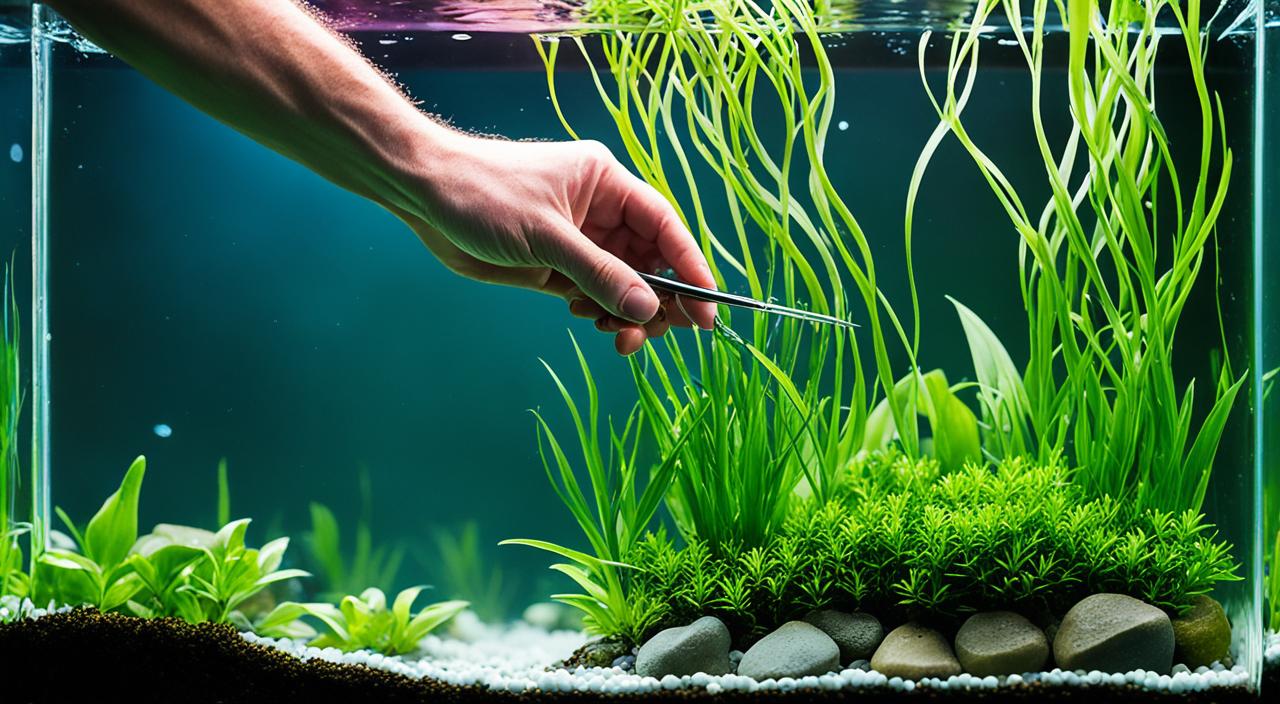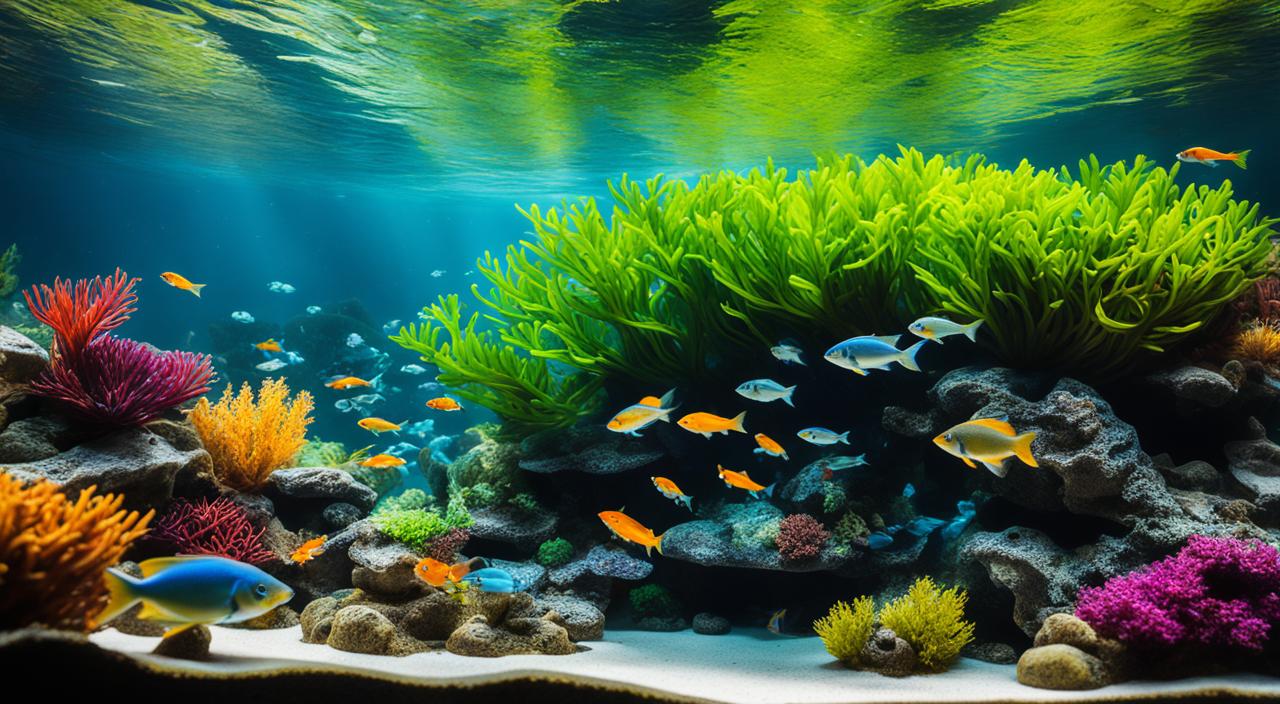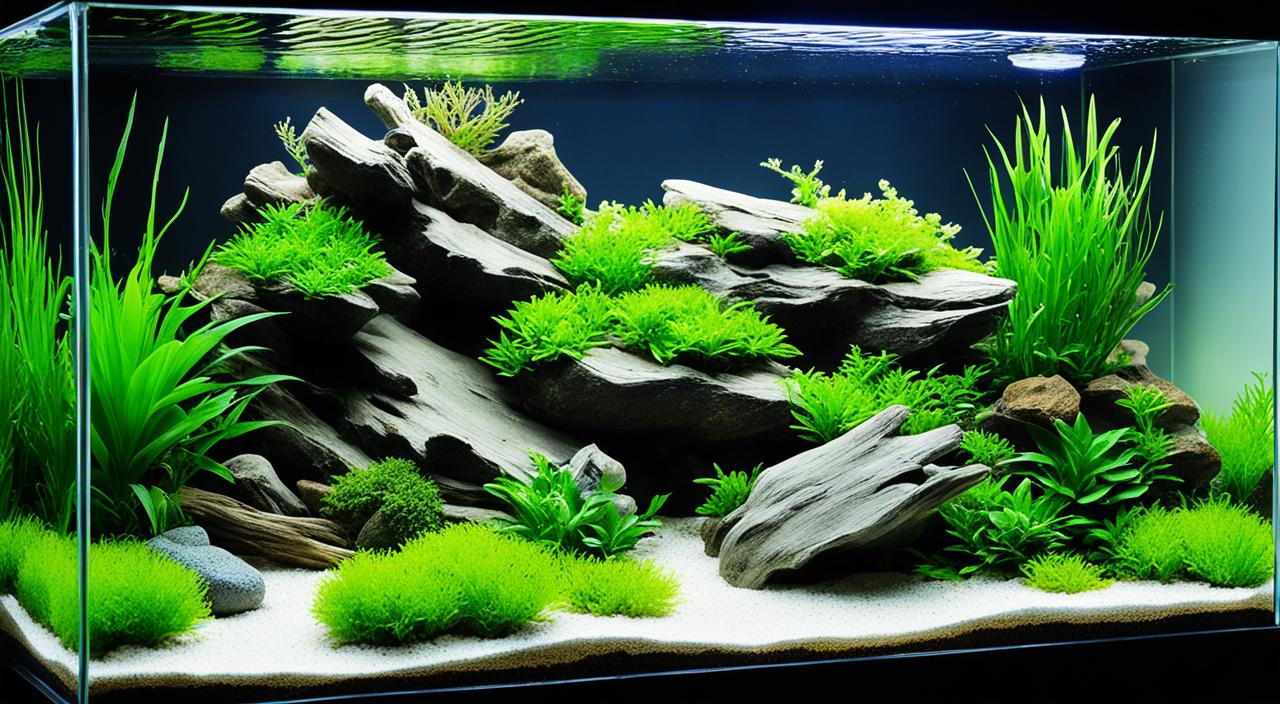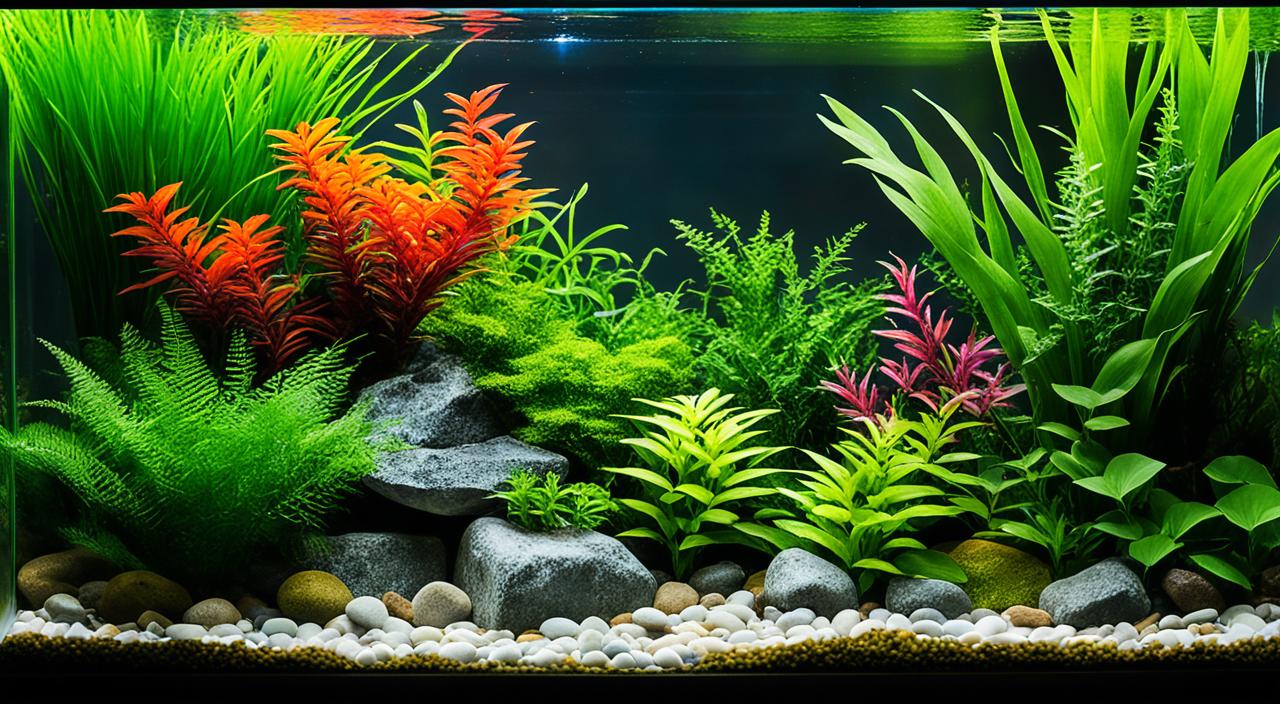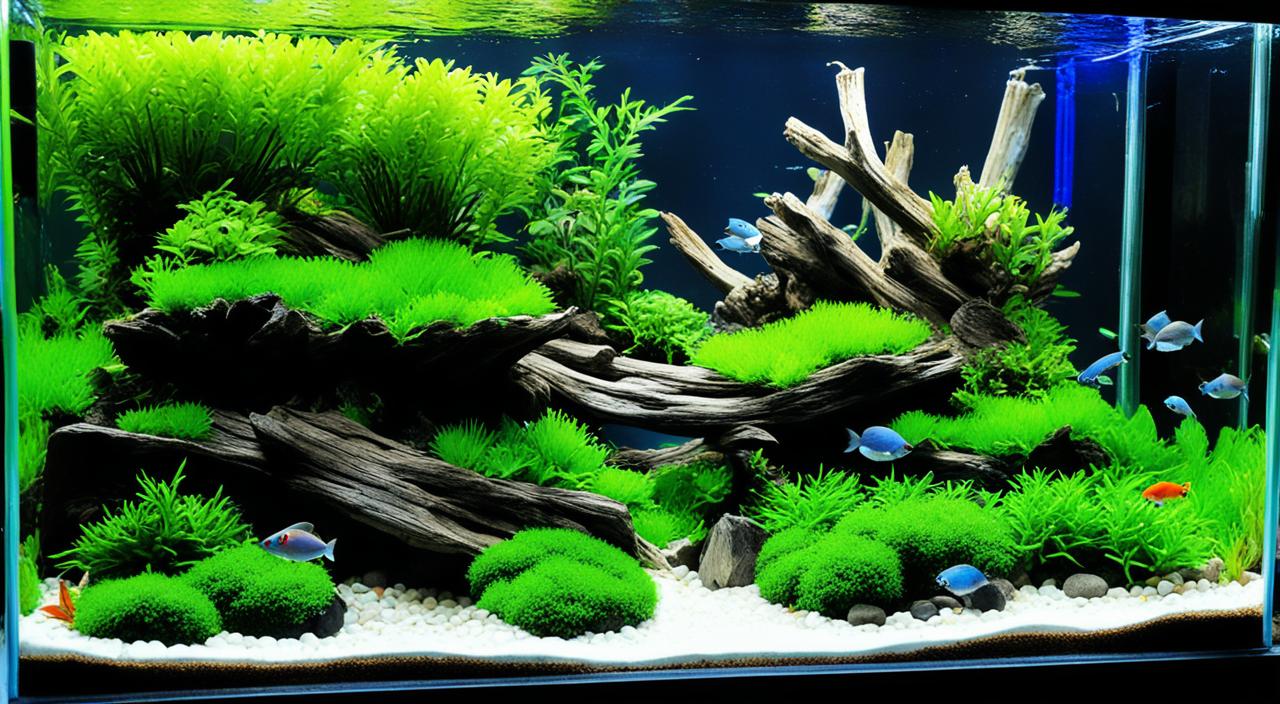Hello, fellow aquascaping enthusiasts! This article will explore the essential techniques and principles of aquascaping basics. Whether you’re a beginner or an experienced aquarist looking to improve your skills, understanding these fundamentals will set you on the path to creating stunning underwater landscapes.
Aquascaping is not just about arranging plants and decor in an aquarium. It is a harmonious blend of aquatic horticulture and design principles. By meticulously selecting and arranging elements such as aquatic plants, stones, driftwood, and rocks, you can create a captivating aquascape that mimics the beauty of nature.
When delving into aquascaping, it’s crucial to grasp the basic principles underpinning this art form. Simplicity is essential, as overcrowding can detract from the overall aesthetic. Variety adds visual interest, creating a dynamic and engaging aquascape. Proportion ensures balance and harmony, while persistence is necessary to refine your skills and find the perfect combination of styles and layouts.
You’ll need the right tools and elements to execute an aquascape successfully. Lighting is essential for the health and growth of aquatic plants. Water filters help maintain water cleanliness and ensure a thriving environment. Carbon dioxide systems and liquid fertilizers provide the necessary nutrients for plant growth. The choice of substrate and hardscape materials, such as driftwood and rocks, contribute to the overall visual appeal of your aquascape.
Now, let’s dive deeper into the techniques and principles that will help you master the art of aquascaping basics.
Key Takeaways:
- Aquascaping is the art of arranging aquatic plants, stones, driftwood, and rocks in an aesthetically pleasing way in an aquarium.
- Basic principles of aquascaping include simplicity, variety, proportion, and persistence.
- Lighting, water filters, carbon dioxide systems, liquid fertilizers, substrate, and hardscape materials are essential for successful aquascaping.
Basic Aquascaping Principles
Aquascaping is an art form that follows a set of basic principles to create stunning and harmonious underwater landscapes. Understanding these principles is essential for aquascapers to achieve aesthetically pleasing results.
Simplicity
The principle of simplicity in aquascaping emphasizes the concept that less is more. Aquascapes can create a clean and visually appealing aquascape by avoiding overcrowding the tank with too many elements, such as plants, rocks, or decorations. This allows for better focal points and a sense of tranquillity within the aquarium.
Variety
Creating visual interest in an aquascape is achieved through the principle of variety. Incorporating a diverse selection of aquatic plants, hardscape materials, and layout designs adds vibrancy and depth to the tank. By carefully selecting elements with different colours, textures, and shapes, aquascapes can bring life and uniqueness to their aquascape.
Proportion
Proportion is a fundamental principle in aquascaping that ensures a sense of harmony and balance within the tank. It involves considering the ratio between open and filled space in the aquarium. By achieving a well-balanced distribution, aquascapes can create a visually pleasing arrangement that feels cohesive and natural.
Persistence
Aquascaping can be a challenging and iterative process that requires patience and persistence. It involves constant experimentation, adjustment, and refinement to find the perfect combination of styles and layouts. By persistently exploring different techniques and learning from successes and failures, aquascapers can continuously improve their skills and create captivating aquascapes.
| Principle | Description |
|---|---|
| Simplicity | Achieves balance and harmony by considering the ratio between open and filled space in the tank. |
| Variety | Utilizes a diverse selection of plants, materials, and designs to add visual interest and vibrancy to the aquascape. |
| Proportion | Achieves a sense of balance and harmony by considering the ratio between open space and filled space in the tank. |
| Persistence | Requires constant experimentation, adjustment, and refinement to create captivating aquascapes. |
Aquascaping Essentials
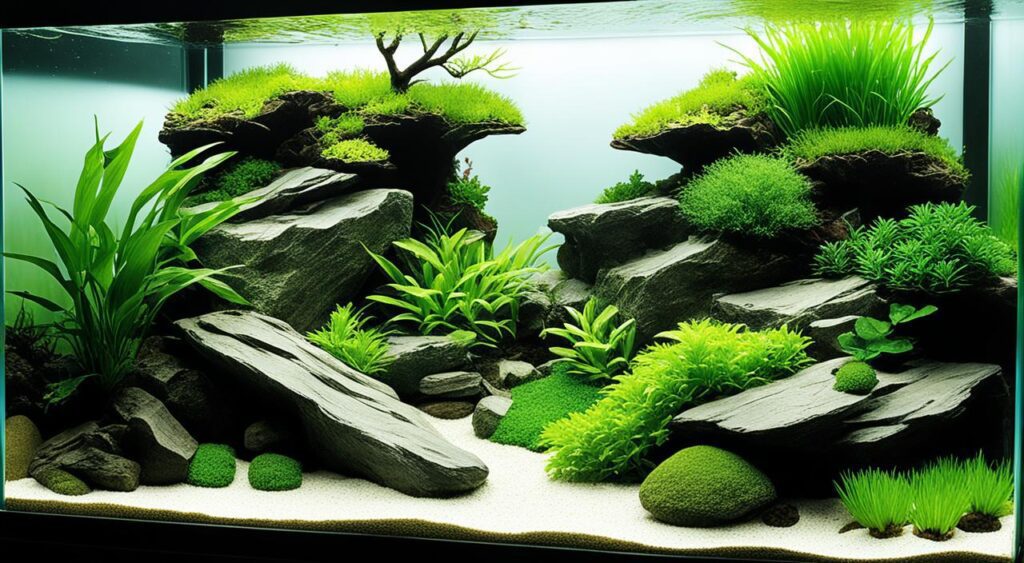
When it comes to aquascaping, there are certain essential equipment and elements that every enthusiast should consider. These essentials play a crucial role in creating a thriving and visually stunning aquascape. Let’s take a closer look at each of these elements:
Aquascape Lighting
Lighting is vital for the health and growth of aquatic plants in your aquarium. It provides the necessary energy for photosynthesis, ensuring your plants can thrive and flourish. The proper lighting setup will enhance the beauty of your aquascape and promote the growth of vibrant and lush plants.
Aquascape Water Filters
Water filters are essential for maintaining water cleanliness and removing pollutants that can hinder aquatic plants’ growth and harm the ecosystem. They help remove impurities, excess nutrients, and debris, ensuring a healthy and balanced aquatic environment.
Aquascape Carbon Dioxide
Aquascapes often utilise carbon dioxide (CO2) injection systems to promote optimal plant growth. Carbon dioxide is an essential nutrient for plants, and supplementing it can encourage faster and healthier growth. CO2 systems help maintain this vital gas’s proper balance, providing the conditions for plants to thrive.
Aquascape Liquid Fertilizers
Like land-based plants, aquatic plants require nutrients to grow and stay healthy. Liquid fertilizers are a convenient and effective way to provide these essential nutrients to aquatic plants. They contain a blend of macro and micronutrients readily absorbed by the plants, promoting their growth and overall vitality.
Aquascape Substrate
The choice of substrate is crucial in aquascaping as it provides anchorage for plants and supports their growth. The substrate serves as a source of nutrients and contributes to the overall aesthetics of the aquascape. It can range from gravel to specialized substrates explicitly designed for planted aquariums.
Aquascape Hardscape Materials
Hardscape materials such as driftwood and rocks add visual appeal and natural elements to the aquascape. They create dimension and texture and provide hiding places for fish and shrimp, making the aquarium more visually enticing and creating a natural habitat for the inhabitants.
By understanding and incorporating these aquascaping essentials into your setup, you’ll be well on your way to creating a captivating and thriving aquascape that will be the envy of fellow enthusiasts.
| Aquascaping Essentials | Benefits |
|---|---|
| Aquascape Lighting | Enhances plant growth and visual appeal |
| Aquascape Water Filters | Maintains water cleanliness and removes pollutants |
| Aquascape Carbon Dioxide | Promotes healthy plant growth |
| Aquascape Liquid Fertilizers | Provides essential nutrients for plants |
| Aquascape Substrate | Supports plant growth and nourishment |
| Aquascape Hardscape Materials | Adds visual appeal and natural elements |
Elemental Rules in Aquascaping Visual Construction and Setup
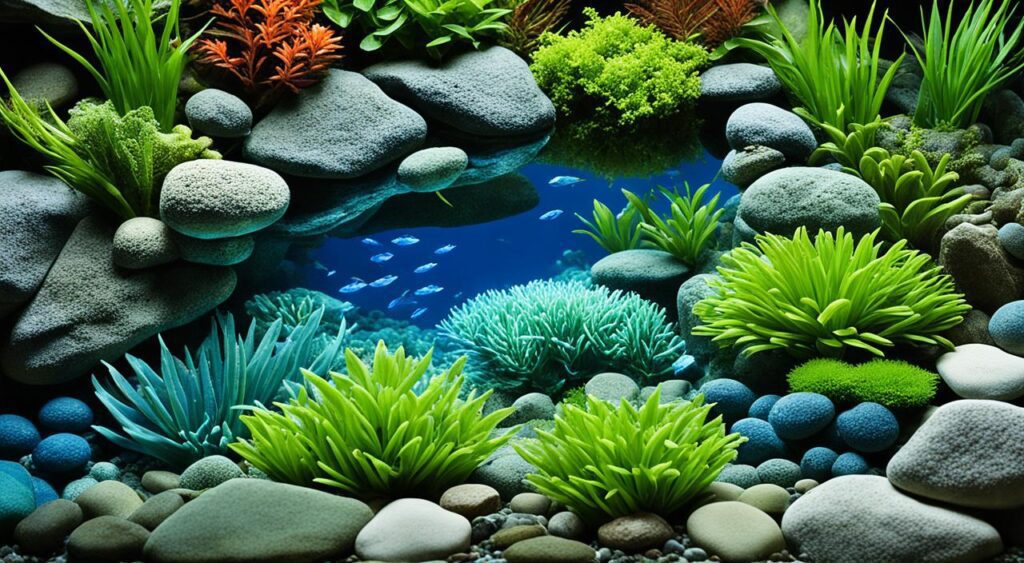
When it comes to creating an aquascape, there are certain visual construction and setup rules that you should follow to achieve a visually stunning and well-balanced result. These rules not only enhance the overall aesthetics of your aquascape but also contribute to creating a harmonious and inviting underwater environment.
The Rule of Thirds in Aquascaping
One of the fundamental principles in aquascaping is the rule of thirds. This principle involves dividing your aquascape into a grid of nine equal parts by drawing two equally spaced vertical lines and two equally spaced horizontal lines. The intersections of these lines create focal points and points of interest in your aquascape.
By placing key elements such as hardscape materials and plants along these intersecting lines or around the focal points, you can create a visually appealing composition that draws the viewer’s attention and adds depth to your aquascape.
The Golden Ratio in Aquascaping
Another essential rule in aquascaping is the use of the golden ratio. The golden ratio is a mathematical concept reflecting an aesthetically pleasing proportion and balance in nature. It can be applied to aquascaping to determine the placement of key elements and create a focal point that captures the viewer’s gaze.
You can achieve a sense of harmony and balance by strategically positioning elements in your aquascape according to the golden ratio. This can be done by placing the focal point at a distance of approximately 1.618 times the width from one edge or arranging elements in a spiral pattern that follows the golden ratio.
Using the golden ratio in your aquascaping setup adds a touch of natural beauty and elegance, enhancing its overall visual appeal.
The Importance of a Focal Point
In aquascaping, creating a focal point is vital. A focal point is a visually striking element or area in your aquascape that immediately catches the viewer’s attention. It acts as the centrepiece and is your aquascape’s primary visual interest point.
By carefully selecting and positioning plants, rocks, or other eye-catching elements, you can create a focal point that draws the viewer’s gaze and adds depth and perspective to your aquascape. The focal point serves as a visual anchor, emphasizing the overall design and adding visual interest to the aquascape.
When creating your aquascape, consider incorporating a focal point that complements your chosen overall theme and style. Whether it’s a vibrant plant arrangement or an intricately designed rock formation, a well-established focal point can genuinely elevate the visual impact of your aquascape.
Remember, the rule of thirds, the golden ratio, and incorporating a focal point are essential guidelines when constructing and setting up your aquascape. They help create depth, perspective, and visual interest, creating a visually stunning and harmonious underwater environment.
Aquascaping Styles
Aquascaping offers a range of styles to cater to diverse preferences and desired aesthetics. One popular style is the Dutch-style aquascape, which focuses on meticulously cultivating and arranging aquatic plants to create stunning underwater gardens. This style often showcases a vibrant and colourful display of plants in different sizes and shapes, creating a visually striking and well-balanced aquascape.
Another captivating style is the Jungle-style aquascape, which aims to create a lush, untamed appearance reminiscent of a dense tropical rainforest. In this style, plants can grow freely and organically, creating a captivating greenery scene and a natural and wild ambience.
The Iwagumi-style aquascape, on the other hand, emphasizes simplicity and harmony through the artful placement of rocks. The main focus is arranging a few carefully selected rocks, often following specific patterns, such as the iconic triangular composition. This style creates a sense of tranquility and elegance with a minimalist approach that highlights the beauty of the rocks and the negative space around them.
The Nature Aquarium-style aquascape aims to recreate the look and feel of a natural underwater environment, reflecting elements found in the wild. This style combines hardscape materials like rocks and driftwood with diverse aquatic plants to create a harmonious balance between nature and art. The result is a captivating aquascape miming the serenity and beauty of a forest stream or a tranquil lake.
FAQ
What is aquascaping?
Aquascaping is the art of arranging elements such as aquatic plants, stones, driftwood, and rocks in an aesthetically pleasing way in an aquarium.
What are the basic principles of aquascaping?
The basic principles of aquascaping are simplicity, variety, proportion, and persistence.
What equipment and elements are essential for aquascaping?
Essential equipment and elements for aquascaping include lighting, water filters, carbon dioxide systems, liquid fertilizers, substrate, and hardscape materials.
What are the rules in aquascaping visual construction and setup?
The rules in aquascaping visual construction and setup include the rule of thirds, the golden ratio, and creating a focal point.
What are some popular aquascaping styles?
Popular aquascaping styles include the Dutch style, Jungle style, Iwagumi style, and Nature Aquarium style.

